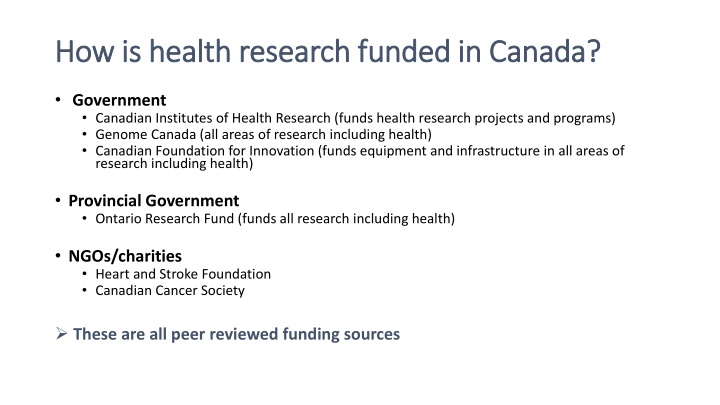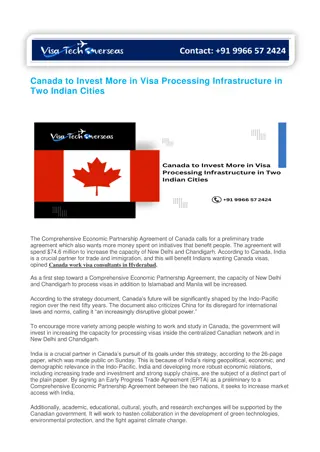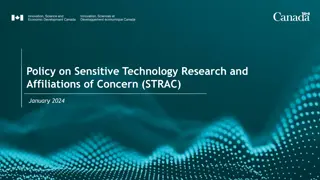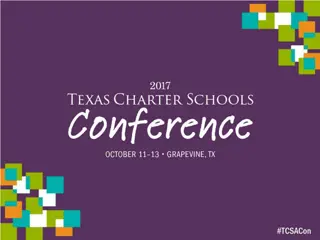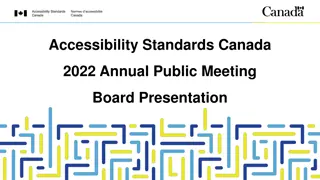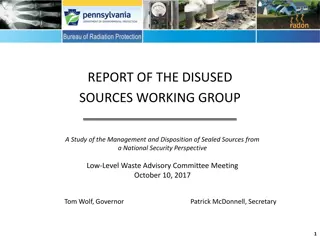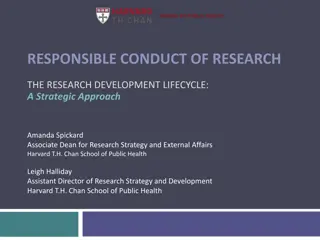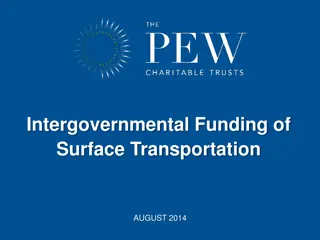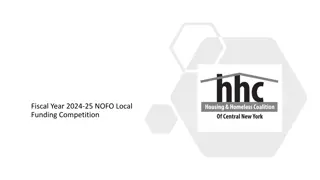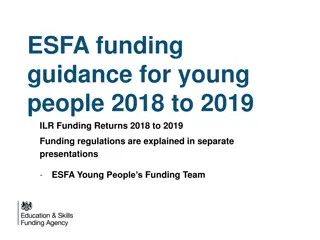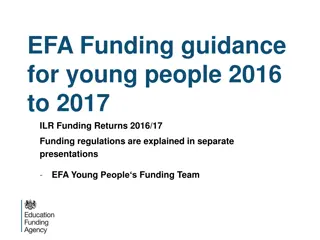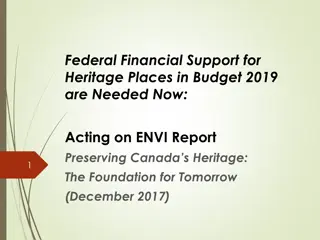Funding Sources for Health Research in Canada
In Canada, health research is funded by various entities, including the Canadian Institutes of Health Research, Genome Canada, Canadian Foundation for Innovation, provincial governments, and NGOs/charities like the Heart and Stroke Foundation and Canadian Cancer Society. The Canadian government plays a significant role in funding health research through these organizations, supporting a range of research projects and programs. Federal funding for health research is channeled through agencies like the Canadian Institutes of Health Research, which annually invests around $1 billion in health research initiatives. Despite consistent funding levels over the past decade, the costs of research have increased.
Download Presentation

Please find below an Image/Link to download the presentation.
The content on the website is provided AS IS for your information and personal use only. It may not be sold, licensed, or shared on other websites without obtaining consent from the author.If you encounter any issues during the download, it is possible that the publisher has removed the file from their server.
You are allowed to download the files provided on this website for personal or commercial use, subject to the condition that they are used lawfully. All files are the property of their respective owners.
The content on the website is provided AS IS for your information and personal use only. It may not be sold, licensed, or shared on other websites without obtaining consent from the author.
E N D
Presentation Transcript
How is health research funded in Canada? How is health research funded in Canada? Government Canadian Institutes of Health Research (funds health research projects and programs) Genome Canada (all areas of research including health) Canadian Foundation for Innovation (funds equipment and infrastructure in all areas of research including health) Provincial Government Ontario Research Fund (funds all research including health) NGOs/charities Heart and Stroke Foundation Canadian Cancer Society These are all peer reviewed funding sources
Federal funding for health research Federal funding for health research
Canadian Institutes of Health Research Canadian Institutes of Health Research The Government of Canada (GoC) health research investment agency with a granting capacity of $1 billion each year ~$550 Million to investigator-initiated research programs ~$450M to research in priority areas, long-standing initiatives (e.g. HIV/AIDS), Canada Research chairs. One of three Federal agencies (known as Tri-Council) other two support natural sciences & engineering and social sciences & humanities, respectively. CIHR was created in 2000 and reports to Parliament through the Minister of Health.
Canadian Institutes of Health Research Canadian Institutes of Health Research CIHR Investments from 2008-09 to 2017-18 $1,200 $1,000 $800 CIHR Grants Expenditures $ (Millions) $600 $400 CIHR Total Budget $200 $0 2008 09 2009 10 2010 11 2011 12 2012 13 2013 14 2014 15 2015 16 2016 17 2017 18 Years Little change in amount of funds invested in research at CIHR for 10 years +Cost of research up
Canada Foundation for Innovation Canada Foundation for Innovation Independent corporation created by the GoC, which invests in state-of-the-art infrastructure/equipment to enable world-class research (~$350M/year). The CFI funds up to 40% of a project s research infrastructure costs. Institutions secure the remaining 60% through partnerships with provincial governments and other public, private and non-profit organizations. CFI funds all types of research, not just health research (flat$ but +researchers applying)
Fundamental Science Review Fundamental Science Review Commissioned by Federal Government in 2017 (David Naylor massive report) Identified major deficiencies for government funding for research in Canada for example, little increase to funding to tri-agencies and CFI to meet the increase in researchers Advocated for a major re-investment in the Canadian research enterprise
Fundamental Science Review Fundamental Science Review GERD = Gross Domestic Expenditures in R&D
Fundamental Science Review Fundamental Science Review 31% reduction funding per researcher compared to peak in ~2007-8
Funding since the Fundamental Science Review Funding since the Fundamental Science Review CIHR Investments investments since budget 2018 compared to 2017-18 baseline 1,200 1,000 800 $ (Millions) CIHR Total Budget 600 Investigator Initiated grants 400 200 0 2017 18 2018-19 2019-20
Yet no increase in success rates Yet no increase in success rates Success rate from 2005-2010 was 26%, today it hovers around 15% out of 2358 applications submitted Researchers need to undertake their research project with up to 25% less funding than requested = 15% success rate
Charitable organization funding for health Charitable organization funding for health research research
Charitable Sector in Canada Charitable Sector in Canada Charities + NFP=170,000 in social good sector. Charities + NFP = 8.1% GDP, employ 2.4M, 70% women. Impact of Covid-19 Moderate economic downturn -$9.5 billion and -117,000 employees. Severe economic downturn -$15.6 billion and -194,000 employees.
Philanthropic support Direct or Indirect Philanthropic support Direct or Indirect Charities tend to be structured as either Flow through-funds donated to organization that re-directs to various funded organizations (Heart and Stroke Foundation). OR Charities representing an anchor such as a hospital or university and supported by dedicated Foundation (Heart Institute Research Corporation).
Heart and Stroke Foundation Heart and Stroke Foundation The main fundraising body for heart and stroke research in Canada. Investment into research programs is at ~$30M per year, and is broken up into the investigator-driven Grant-in-Aid program, personnel support programs and priority-driven strategic research funds opportunities. Ability to fund research greatly affected by COVID-19 pandemic
Canadian Cancer Society Canadian Cancer Society The main fundraising body for cancer research in Canada. Investment into research programs is at ~$46M per year, broken into research targeted specific cancers (~$34M) and research applicable to multiple cancers (~$12M) Ability to fund research greatly affected by COVID-19 pandemic
COVID COVID- -19: 19: effect on fundraising for research effect on fundraising for research Short term example of Heart and Stroke Foundation funding to University of Ottawa Heart Institute (UOHI) in 2020 These grants ranked excellent following peer reviewed and were approved for funding. These is the amount that would have been awarded prior to pandemic $1M cut due to COVID
Impact of philanthropy on health research Impact of philanthropy on health research
The Next Frontier in Coronary Artery Bypass Grafting (CABG): Robotics HYBRID OR and HEART TEAMS will be CRITICAL to ROBOTIC CABG expansion
Leveraging philanthropy Leveraging philanthropy Philanthropic funding seed grants to help researchers compete at the federal agencies such as CIHR ($1 philanthropic support attracts multiples 5-15X) Provides competitive advantage through generation of preliminary findings and data to strengthen the application Funding grants that ranked as excellent and fundable at the federal agencies but were not funded due to limitations in local funding Injecting funds into entirely new areas of enquiry/research that can be difficult to get funded at risk-adverse federal agencies Scientists from different areas working together (multidisciplinary) Clinicians and scientists working together (e.g. clinicians providing input into research needs) Patients input to help design research studies, the outcomes of which, matter to the patient
Research Program in Brain and Heart Connections Research Program in Brain and Heart Connections Research findings & clinical observations indicate major linkages between Heart Disease & Brain/Mind Diseases, and poor patient outcomes with co-occurring conditions Stroke Heart Failure Cognitive Impairment / Dementia Atrial Fibrillation Depression Congenital Heart Disease Anxiety & PTSD
CANADIAN FIRST Completely Non-Invasive Cardiac Radio-Ablation to Treat Life-Threatening Arrhythmia A team of doctors at the University of Ottawa Heart Institute (UOHI), in partnership with their colleagues at The Ottawa Hospital Cancer Centre, successfully performed the country s first completely non-invasive cardiac radio-ablation without incident. The Heart Institute is now believed to be one of the only heart centers in the world capable of performing this completely non-invasive procedure to treat heart disease. . 2019
Where from here? Where from here? Who can pay the price Who can pay the price Taxpayers or the Community Taxpayers or the Community Renewed commitment from all levels of government to prioritize research funding, not just infectious diseases and healthcare Think BIG -high-end donors are attracted to investing in big ideas Artificial intelligence is the future, who is driving, funding, integrating Reliable and consistent funding attracts the world s brightest Increased emphasis on innovation (KSFs) what does success look like?
Biden BIG Research Investment Biden BIG Research Investment $250 billion on the U.S. research enterprise over the next several years. Rebuild the country s infrastructure, create jobs, and out-innovate the rest of the world. Targets $180 billion specifically for R&D and the technologies of the future . Additional $70 billion in research-related areas ranging from combating pandemics to bolstering innovation in rural areas.
